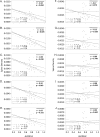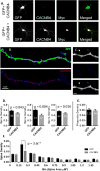Selective Loss of Smaller Spines in Schizophrenia
- PMID: 28359200
- PMCID: PMC5800878
- DOI: 10.1176/appi.ajp.2017.16070814
Selective Loss of Smaller Spines in Schizophrenia
Abstract
Objective: Decreased density of dendritic spines in adult schizophrenia subjects has been hypothesized to result from increased pruning of excess synapses in adolescence. In vivo imaging studies have confirmed that synaptic pruning is largely driven by the loss of large or mature synapses. Thus, increased pruning throughout adolescence would likely result in a deficit of large spines in adulthood. Here, the authors examined the density and volume of dendritic spines in deep layer 3 of the auditory cortex of 20 schizophrenia and 20 matched comparison subjects as well as aberrant voltage-gated calcium channel subunit protein expression linked to spine loss.
Method: Primary auditory cortex deep layer 3 spine density and volume was assessed in 20 pairs of schizophrenia and matched comparison subjects in an initial and replication cohort (12 and eight pairs) by immunohistochemistry-confocal microscopy. Targeted mass spectrometry was used to quantify postsynaptic density and voltage-gated calcium channel protein expression. The effect of increased voltage-gated calcium channel subunit protein expression on spine density and volume was assessed in primary rat neuronal culture.
Results: Only the smallest spines are lost in deep layer 3 of the primary auditory cortex in subjects with schizophrenia, while larger spines are retained. Levels of the tryptic peptide ALFDFLK, found in the schizophrenia risk gene CACNB4, are inversely correlated with the density of smaller, but not larger, spines in schizophrenia subjects. Consistent with this observation, CACNB4 overexpression resulted in a lower density of smaller spines in primary neuronal cultures.
Conclusions: These findings require a rethinking of the overpruning hypothesis, demonstrate a link between small spine loss and a schizophrenia risk gene, and should spur more in-depth investigations of the mechanisms that govern new or small spine generation and stabilization under normal conditions as well as how this process is impaired in schizophrenia.
Keywords: Calcium Channel; Dendritic Spines; Neuropathology; Proteomics; Schizophrenia.
Conflict of interest statement
Dr. MacDonald reports no competing interests
Dr. Alhassan reports no competing interests
Dr. Newman reports no competing interests
Dr. Richards reports no competing interests
Dr. Gu reports no competing interests
Dr. Sampson reports no competing interests
Dr. Fish reports no competing interests
Dr. Penzes reports no competing interests
Dr. Wills reports no competing interests
Dr. Sweet reports no competing interests
Figures



Comment in
-
Cortical Pyramidal Neurons Show a Selective Loss of New Synapses in Chronic Schizophrenia.Am J Psychiatry. 2017 Jun 1;174(6):510-511. doi: 10.1176/appi.ajp.2017.17030318. Am J Psychiatry. 2017. PMID: 28565949 No abstract available.
References
-
- Feinberg I. Schizophrenia: caused by a fault in programmed synaptic elimination during adolescence? J Psychiatr Res. 1982;17(4):319–334. - PubMed
-
- Chen X, et al. Functional mapping of single spines in cortical neurons in vivo. Nature. 2011;475(7357):501–505. - PubMed
-
- Midtgaard J. The integrative properties of spiny distal dendrites. Neuroscience. 1992;50(2):501–502. - PubMed
Publication types
MeSH terms
Substances
Grants and funding
LinkOut - more resources
Full Text Sources
Other Literature Sources
Medical

